According to the Unicode Consortium, the nonprofit organization devoted to ensuring the standardization of emoticons across different devices (among other things), as many as 92% of people use emojis.
Considering how many of us use online communication tools for work, it’s no surprise that emojis have also infiltrated our professional lives.
In the last quarter of 2020, about 77% of people reported using emojis at work — a number that has surely increased in the years since.
But, though this number does reveal the popularity of emojis in business communication, it doesn’t tell us much about:
- The advantages and disadvantages of emojis in business communication,
- How people really use emojis at work (and in general), and
- How we can adjust the way we use emojis to improve communication outcomes at work.
For those insights and more, check out the emoji statistics we have compiled below.
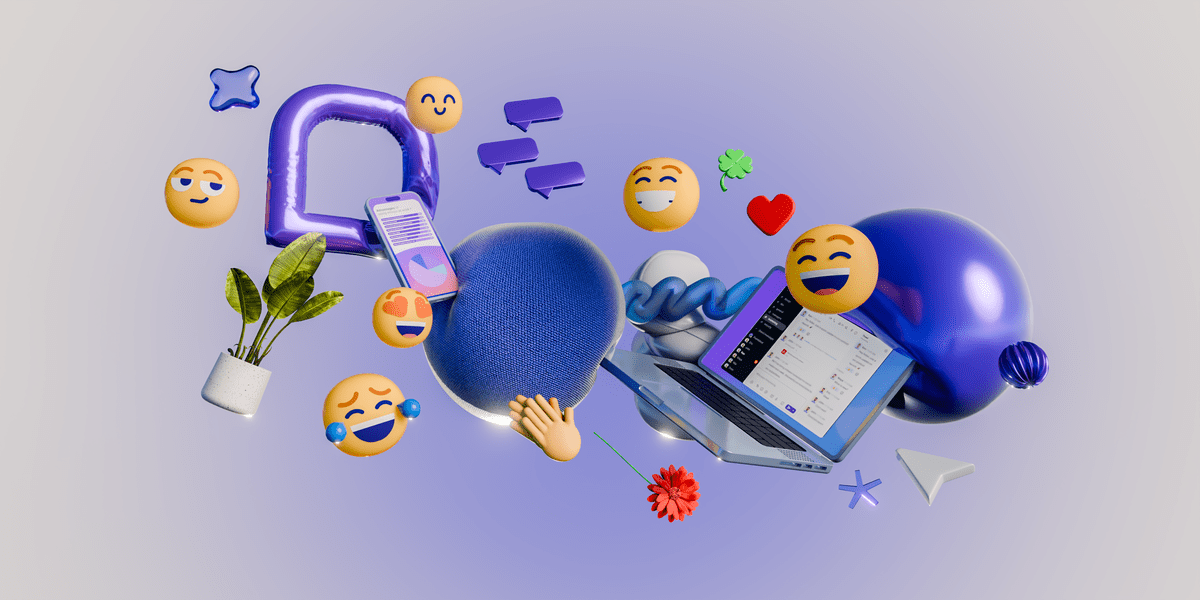
- 88% of Gen Z workers find emojis helpful when communicating with coworkers, as opposed to 49% of Gen X and Boomer knowledge workers.
- 81% of Americans have been confused by someone else’s use of an emoji.
- 65% of knowledge workers use emojis to convey tone in written communication.
- 48% of Americans have seen a misinterpreted emoji cause an uncomfortable situation.
- 44% of Gen Z workers prefer to ascribe ironic meanings to emojis, as opposed to 17% of Millennials, 14% of Baby Boomers, and 12% of Gen Xers.
Should you use emojis in business communication?
A decade ago, most people felt apprehensive about using emojis at work.
Even as recently as 2019, 72% of Adobe’s survey respondents reported feeling hesitant to use emojis in the workplace.
Yet, according to Adobe’s 2022 US Emoji Trend Report, 71% of survey respondents claimed to have used emojis in a work setting.
So, what’s changed?
Well, with the recent rise of remote and hybrid work models, most people have transitioned to using more written communication in the workplace.
According to a 2024 report from Atlassian’s Teamwork Lab, 93% of the 10,000 surveyed knowledge workers regularly communicate in writing at work.
However, even though this type of communication is great for keeping people accountable, it also has a major flaw — it doesn’t always convey the tone of our message.
Because of that, 64% of Atlassian’s survey participants report wasting time trying to interpret written messages from their coworkers.
That’s why emojis have quickly become a crucial aspect of team communication, allowing us to emote even in textual exchanges.
After all, research shows the affective power of emojis is similar to that of real faces. According to one 2025 survey of the emoji habits of 500 US employees:
- 17% of employees agree the most significant benefit of sharing emojis at work is that they can express a message tone without words, and
- 14% found emojis helpful in expressing emotions virtually.
Aside from that, emojis can also be used to direct the reader’s attention to relevant information, as seen in the example below.
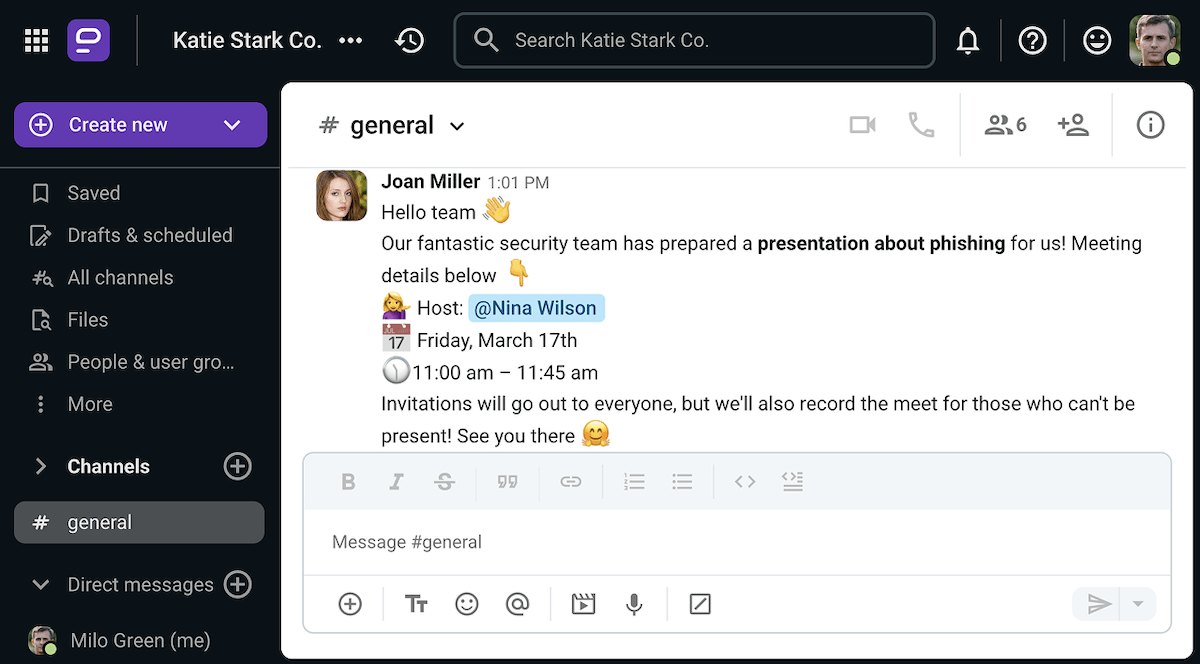
Make your company announcements pop on Pumble
🎓 PUMBLE PRO TIP
For a more in-depth answer to the question of whether emojis belong in professional communication, check out the following article:
The benefits of using emojis at work
At this point, it would be difficult to separate emojis from the way we communicate at work or elsewhere.
Still, you’ll be pleased to learn that there are many benefits of using emojis in the workplace, including the fact that they:
- Make communication more clear and succinct,
- Help build personal and professional ties among colleagues, and
- Allow us to share our feelings at work, thus preventing the onset of burnout.
Now, let’s see some numbers to back up those claims.
Benefit #1: Emojis simplify communication
According to Atlassian’s report, emojis may well be the key to solving workplace miscommunication caused by ambiguous messaging.
For example, even though a message like “This is fine” is technically an affirmative response you might send to a coworker, it can also serve as a signal of the sender’s dissatisfaction. This can lead the recipient of the message to wonder what might have set off their coworker.
In any case, following the phrase up with a positive emoji can reinforce the intent behind the message, as seen in the example below.
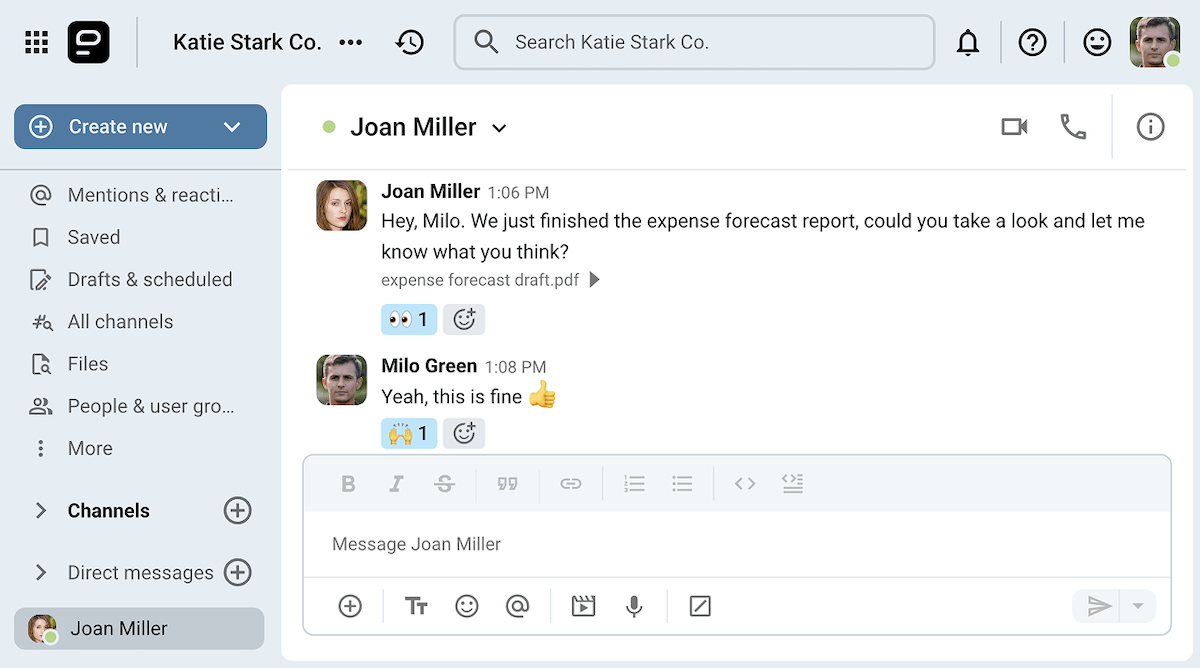
Choose the right emoji for the occasion on Pumble
This is exactly why 65% of the knowledge workers surveyed by Atlassian’s Teamwork Lab use emojis to convey tone in written communication.
Going back to Adobe’s US Emoji Trend Report, we also know that:
- 92% of survey respondents claimed that emojis make communication across language barriers much easier,
- 91% of respondents agreed emojis help them express themselves, and another
- 91% of US emoji users also said that emojis can lighten the mood of a conversation.
On a more practical note, 83% of survey participants noted that emojis take up less character space, allowing them to communicate more efficiently.
This benefit is also evident in the following emoji statistics from the same report:
- 79% of respondents claimed that emojis help employees quickly share ideas,
- 62% believed emojis made the team decision-making process more efficient, and
- 47% believed emojis reduce the need for meetings and calls.
If you’re looking to save time, acknowledging messages with emoji reactions can also be beneficial, as seen in the example below.
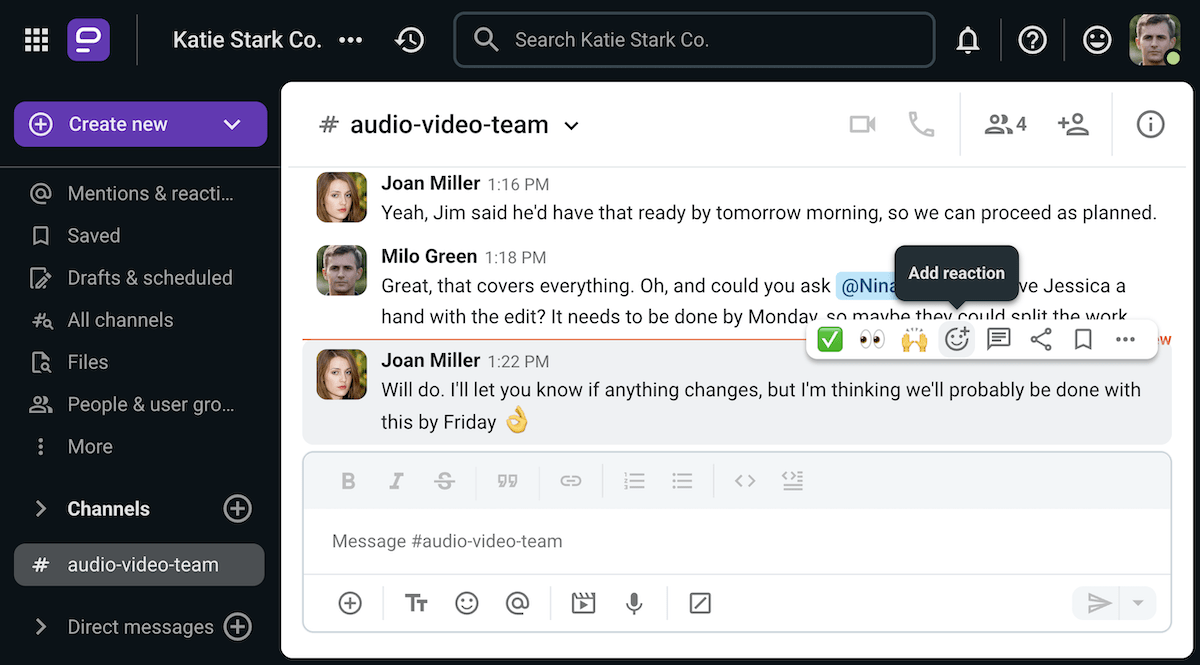
Save time with emoji reactions on Pumble
Benefit #2: Emojis help you connect with your team
According to the findings of the US Emoji Trend Report, using emojis in internal communication can improve our perceptions of the people we work with.
As many as 88% of survey participants claimed to be more likely to empathize with a coworker if they used emojis to communicate, and 73% found those who used emojis to be friendlier and more approachable than those who didn’t.
On top of that:
- 69% of respondents believed that using emojis at work enhanced people’s likeability,
- 68% claimed to like it when their colleagues use emojis in work communication,
- 63% stated they felt more connected to their team as well as their company when coworkers used emojis to communicate, and
- 59% claimed it boosts their credibility.
Emojis even make some people more receptive to new tasks, as:
- 55% of survey participants said that they were more receptive to new tasks when the request is accompanied by an emoji, and
- 50% claimed to be more likely to respond to a message if it contains an emoji.
So, the next time you need to ask for a favor at work, you may want to throw an emoji into the mix.
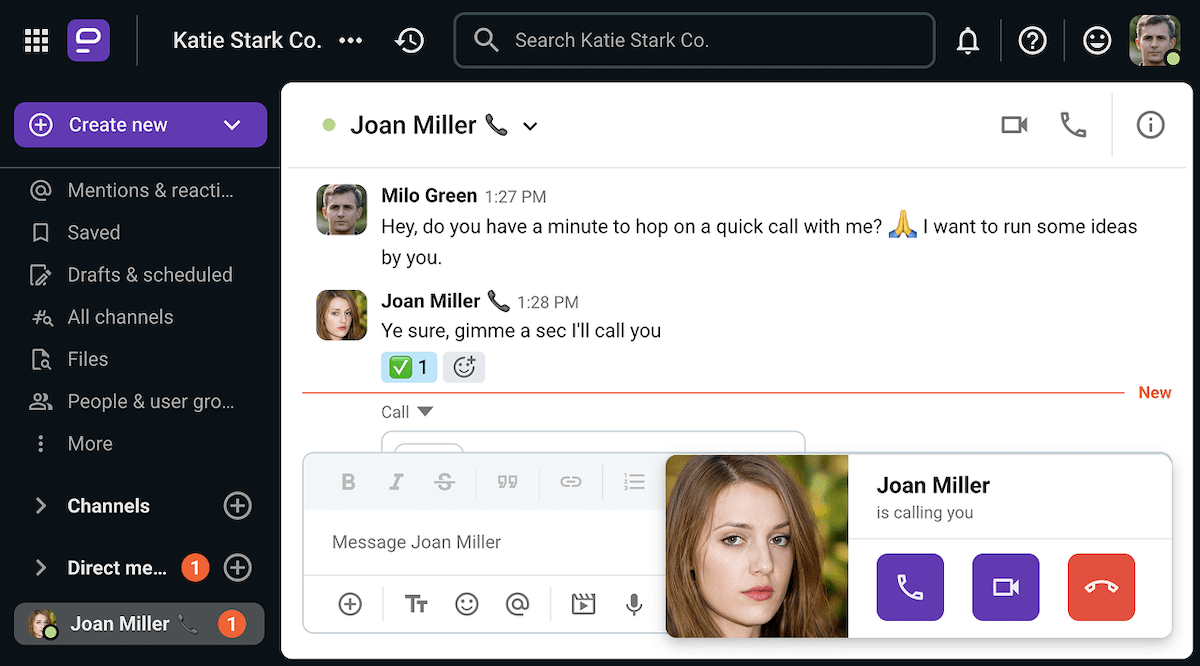
Get a quick response every time — use emojis on Pumble
Benefit #3: Using emojis at work can hold off burnout
Last but not least, using emojis at work may also improve employee mental health, at least according to 60% of Adobe’s 2022 survey respondents.
Research into effective leadership in the digital age has shown that learning how to interpret and use emojis is a great way to:
- Gain a deeper understanding of your employees (and coworkers),
- Become a more empathetic leader,
- Model appropriate emotional cues for different situations, as well as
- Reinforce the company culture.
Furthermore, being able to monitor your remote team’s emotional well-being through the emojis they use might help you prevent employee burnout.
According to research conducted at the University of Michigan, leaders may be able to use emojis as their employees’ emotional proxies.
In other words, these symbols can be used to take the “emotional temperature” of a collective more effectively than perhaps even video calls.
Keeping track of remote workers’ mental conditions in this way may alleviate their stress, resulting in a more positive work environment.
🎓 PUMBLE PRO TIP
No amount of emojis will be able to help you and your team once burnout sets in. However, you can still make a full recovery by following these expert tips:
Potential disadvantages of using emojis at work
As beneficial as the use of emojis in business communication can be, it can also introduce confusion into our everyday conversations at work.
Though the disadvantages of emojis in professional communication aren’t as well-researched as its advantages, Adobe’s 2019 report did point out some general downsides you may want to consider. Of the 1,000 survey participants:
- 60% said emojis can read as impersonal and generic,
- 59% had been sent an emoji that did not match the emotion the sender was trying to convey,
- 57% thought emojis can appear insincere and ingenuine,
- 56% believed emojis could be more inclusive,
- 53% had sent an emoji the other person misinterpreted or took out of context, and
- 35% had sent an emoji they later regretted sending.
With this in mind, we can point to 2 major disadvantages of the use of emojis in business communication:
- Since many emojis have dual meanings, the use of emojis in business communication can lead to misunderstandings.
- Emojis can also have an effect on an individual’s reputation at work, making them appear cold, insincere, or even incompetent.
Then again, even these drawbacks can be alleviated by changing the way you use emojis to communicate.
Having said that, let’s see some general statistics about how most people use emojis before we dive into the way we use them at work, specifically.
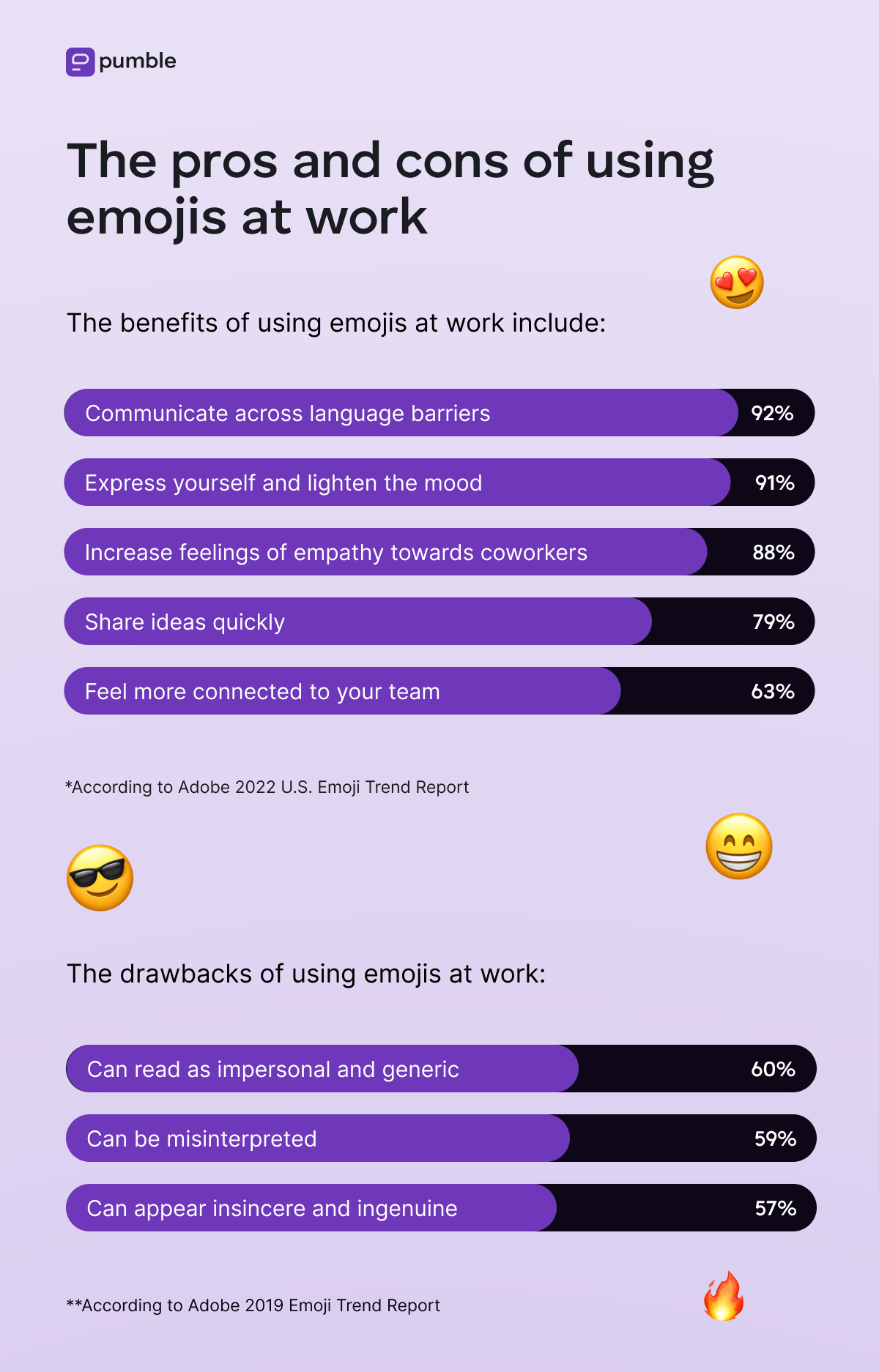
Statistics on emoji usage in 2025
Since their inception in 1999, emojis have been a constant aspect of our digital communication.
However, they have been everything but stagnant, as each passing year brought new additions to our emoji vocabularies.
But, before we discuss the newest of those additions, let’s take a look at the most and least used emojis in the past year.
The most used emojis
According to Meltwater’s analysis of emoji usage across 15 social media platforms, the most popular emojis among social media users from January to November of 2024 were:
- 😭 — Loudly Crying Face (with 761 million mentions),
- 😂 — Face With Tears of Joy (with 586 million mentions),
- 🔥 — Fire (534 million mentions),
- ❤️ — Red Heart (409 million mentions),
- 🤣 — Rolling on the Floor Laughing (286 million mentions),
- 🙏 — Folded Hands (267 million mentions),
- ✨ — Sparkles (253 million mentions),
- 😍 — Smiling Face With Heart Eyes (135 million mentions),
- 🥰 — Smiling Face With Hearts (116 million mentions), and
- 😊 — Smiling Face With Smiling Eyes (69.9 million mentions).
Then again, Emojipedia’s ranking tells a somewhat different story, revealing the following symbols as the most used emojis in 2024:
- ❤️ Red Heart,
- 💀 Skull,
- 😭 Loudly Crying Face,
- 🫶 Heart Hands,
- 😂 Face With Tears of Joy,
- ✅ Check Mark,
- ✨ Sparkles,
- ⭐ Star,
- 🥹 Face Holding Back Tears, and
- 🫡 Saluting Face.
But, even though the 😭 Loudly Crying Face surpassed the 😂 Face With Tears of Joy in terms of frequency of use, we still wouldn’t recommend using the former at work.
If tears must be shown, we suggest you opt for tears of joy — at least while communicating in a professional capacity.
Share your most used emojis with your team on Pumble
The least used emojis
As you can imagine, pointing out emojis that are the least used can be somewhat difficult. However, we still have some clues as to what might be the least used emoji.
According to the Unicode Consortium, flags 🏁🚩🏴☠️ are the least popular category of emojis, even though there are at least 250 of them in the emoji catalog.
Other sources, such as Emojipedia’s Emojitracker bot, show that the following symbol emoji 🔣 was the least used icon on X (before changes in the site’s API made it impossible to track emoji usage on the platform).
On the other hand, a recent report from Superside indicates that the use of emojis has been on a downward trend in general, with the most “endangered” symbols being:
- 👌 the Okay Hand, which dropped 66 places on the list of the most popular emojis,
- 😳 the Blushing Face, which dropped 26 places, and
- 🙌 the Raising Hands, which dropped 18 places.
Of course, corporate vocabulary tends to be slow to adapt to these changes, so you won’t have to worry about not being able to celebrate your team’s wins with the ol’ 🙌 emoji any time soon.
The most misunderstood emojis
Not understanding the most commonly accepted meanings behind different emojis can lead to serious misunderstandings in the workplace.
According to a recent study of American emoji usage from Preply:
- 81% of Americans have been confused by someone else’s use of an emoji, and
- 48% have witnessed a misinterpreted emoji causing an uncomfortable situation.
The table below shows the most confusing emojis of 2024, along with their frequently assigned meanings.
| Emoji | Presumed meanings |
|---|---|
| 💅 Nail Care | 40% Classy or posh/bougie 23% It’s just nail polish 22% Don’t mind me, hehe 15% Self-care |
| 💨 Dash | 38% Dashing away or fast 34% Farting 15% Exhaustion or out of breath 13% Smoking |
| 🙃 Upside-down Smiley | 38% Sarcasm 36% Smiling through pain 16% Same meaning as a regular smiley face 10% Passive aggression |
| 😣 Persevering Face | 40% Frustration 31% Cringe 17% Helplessness 7% Sadness 5% Perseverance or exerting effort |
| 💁♀️ Woman Tipping Hand | 41% Oh well 35% Feeling sassy 19% I have a suggestion 5% Feeling sarcastic |
Even newly introduced emojis with relatively clear meanings, such as the 🙂↔️ Head Shaking Horizontally and 🙂↕️ Head Shaking Vertically emojis, are subject to misinterpretation, as 41% and 43% of survey participants found these symbols confusing.
Though the emojis in question can be used to respond negatively or positively, some people also use them to signify happiness, sleepiness, shyness, and even things like “smug indifference,” “vibing,” and “avoiding drama.”
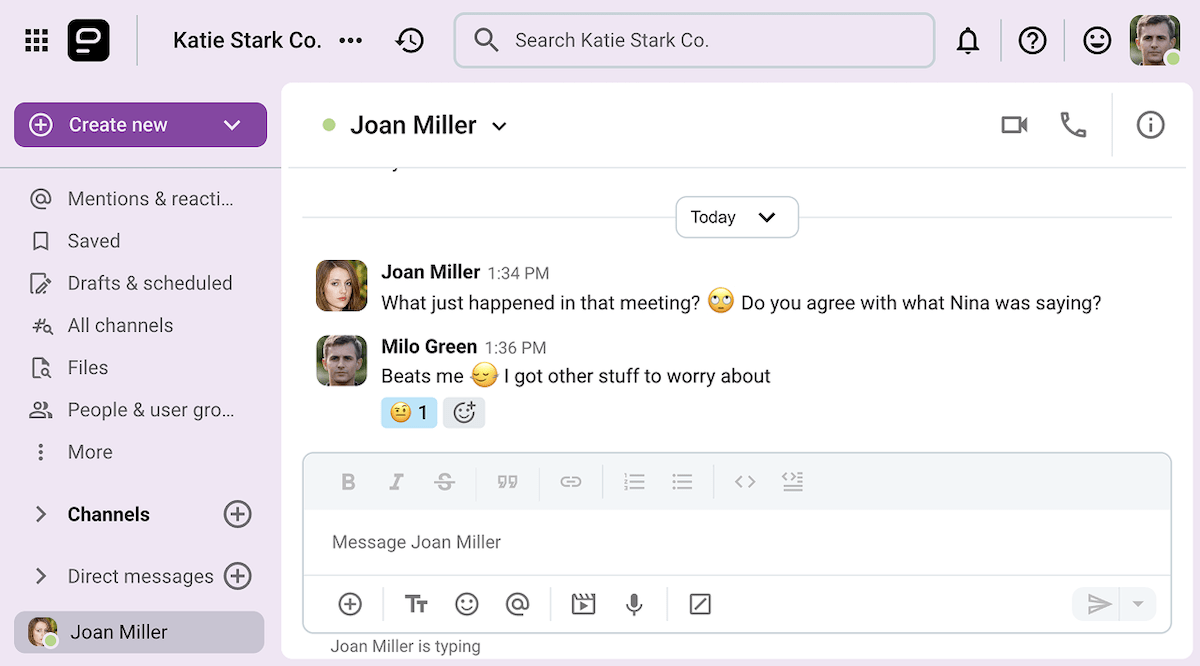
In any case, misusing one of these emojis in business communication can have negative consequences both for your social standing and the status of your projects.
So, if that’s something you’re concerned about, let’s talk about some of the safer emojis you can use at work.
The most and least acceptable emojis in the workplace
According to a Crossword-Solver survey of over 1,000 US employees, the most appropriate emojis to use at work include:
- 👍 Thumbs Up — the most accepted emoji, with 71% voting in its favor,
- 😄 Grinning Face With Smiling Eyes — with 13.7% of respondents choosing it,
- 🙏 Folded Hands — with 11% of employees picking this emoji,
- 😂 Face With Tears of Joy — voted most acceptable by 8.6% of survey respondents, and
- ❤️ Red Heart — with 7.2% of respondents’ votes.
However, the same survey also landed some of these emojis on the list of the least acceptable ones to use in the workplace. Though 😘 Face Blowing a Kiss was deemed the least appropriate for work, with 22.1% of votes, the following emojis also made the list:
- 😭 Loudly Crying Face — with 13.7% of votes,
- ❤️ Red Heart — with 10.5% of votes,
- 🙏 Folded Hands — with 10.5% of votes, and
- 😄 Grinning Face with Smiling Eyes — with 9.8% of respondents’ votes.
Moreover, as noted by the study from Preply on the most confusing emojis, even some commonly accepted emojis could have dual meanings if we take cross-cultural communication into account. Namely:
- 👍 Thumbs Up may be offensive to people from some Middle Eastern countries,
- 👌 OK Sign could be considered obscene or a sign of bad luck by some cultures, and
- ✌️ Peace or Victory Sign can still be interpreted as something akin to the middle finger by some people.
So, when in doubt, it’s best to avoid ambiguous face and hand emojis and instead stick with affirmative symbols like ✅, celebratory emojis like 🎉🎊🥳, and whichever emojis are already in use on your team.
Start using emojis in professional communication on Pumble
New and upcoming emojis
Of the emojis that have entered our lexicon in 2024, two have the potential to enter common usage in the workplace as well — the 🙂↔️ Head Shaking Horizontally and 🙂↕️ Head Shaking Vertically emojis.
According to Meltwater’s analysis, these symbols were mentioned 4.68 and 9.69 million times across social media platforms.
Consequently, the two were also recognized by Emojipedia as the Most Popular New Emoji at the 2024 World Emoji Day Awards, which were unveiled on July 17.
(We’ll give you one chance to guess why World Emoji Day is celebrated on this day. Here’s a hint: 🤔💡👉📅)
Of course, these weren’t the only new additions to the emoji keyboard in recent years. In 2023, Emoji 15.1 also introduced emojis of people walking, kneeling, walking with a white cane, sitting in motorized and manual wheelchairs, and many others, all in different skin tones.
This shows that the Unicode Consortium is committed to delivering what the majority of emoji users have been asking for — diversity.
As the US Emoji Trend Report pointed out, 89% of Gen Z (as well as 86% of Millennials, 81% of Gen X, and 77% of Boomers) agreed that emoji should continue to strive for more inclusive representation.
More recently, though, Unicode has released Emoji 16.0, featuring a new emoji that has the potential to really bring people together at work — the Face with Bags Under Eyes emoji (which was also recognized as the Most Anticipated Emoji by 62.4% of voters on Emojipedia).
Surely, that one will be HR-approved, right?
But, while we’re on the subject of the emojis we might use at work, let’s dive into how most people tend to include these symbols in their internal and external communication.
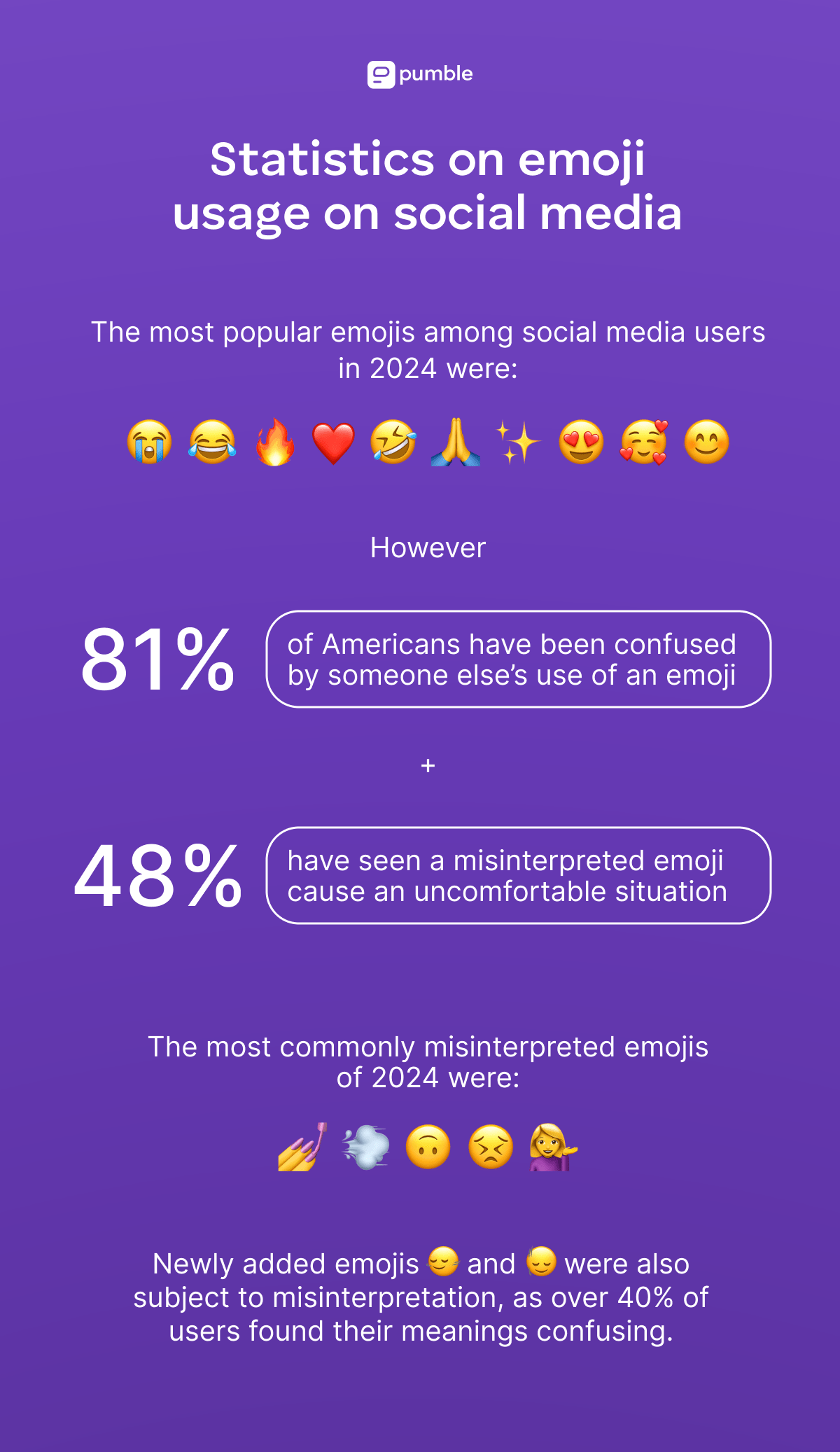
Statistics on the use of emojis in business communication
According to Adobe’s 2022 survey, most people use emojis at work to:
- Express how they feel about a situation — 55% of survey respondents,
- Quickly share approval or feedback — 51% of respondents,
- Communicate positive or negative news — 51% and 21% of respondents, respectively,
- Build relationships with coworkers — 44% of respondents, and
- Increase their chances of getting a response from their coworker — 29% of respondents.
However, the specific ways people talk with emojis tend to depend on factors like:
- Their age,
- The intended recipients of their message, and even
- The channel of communication they’re using to relay their message.
Having said that, let’s see how these factors influence emoji use in business communication.
Generational differences in emoji usage at work
Due to differences in communication styles, younger and older employees tend to have different attitudes toward the use of emojis in the workplace.
For example, the recent report by Atlassian’s Teamwork Lab claimed that Gen Z found emojis more helpful when communicating with coworkers, as:
- 88% of Gen Z workers agreed with that claim, as opposed to
- 49% of Gen X and Boomer knowledge workers.
However, the way different generations choose emojis may result in some misunderstandings between older and younger employees.
According to CNN’s 2024 survey, younger people are much more likely to use emojis ironically than their older counterparts, as shown in the table below.
| Literal meaning | Emotional tone | Irony | |
|---|---|---|---|
| Boomers | 46% | 31% | 14% |
| Gen X | 43% | 36% | 12% |
| Millennials | 32% | 43% | 17% |
| Gen Z | 20% | 30% | 44% |
Though Boomers, Gen Xers, and even Millennials are much more likely to stick to the literal meanings of emojis or use them to accentuate the emotional tone of their messages, Gen Zs seem to prefer using emojis to represent their feelings, often with a hint of irony.
CNN’s survey also showed how this difference in communication styles across generations can cause misunderstandings at work by asking survey participants how they would respond to a coworker’s funny message.
Most generations agreed that the 😂 Face With Tears of Joy emoji was the way to go, with:
- 74% of Gen Xers,
- 71% of Boomers,
- 67% of Millennials, and
- 44% of Gen Zs agreeing with the statement.
However, 28% of Gen Zs and 9% of Millennials also believed that the 💀 Skull emoji would be an appropriate response.
Those who get it, get it — those who don’t… might be a bit confused.
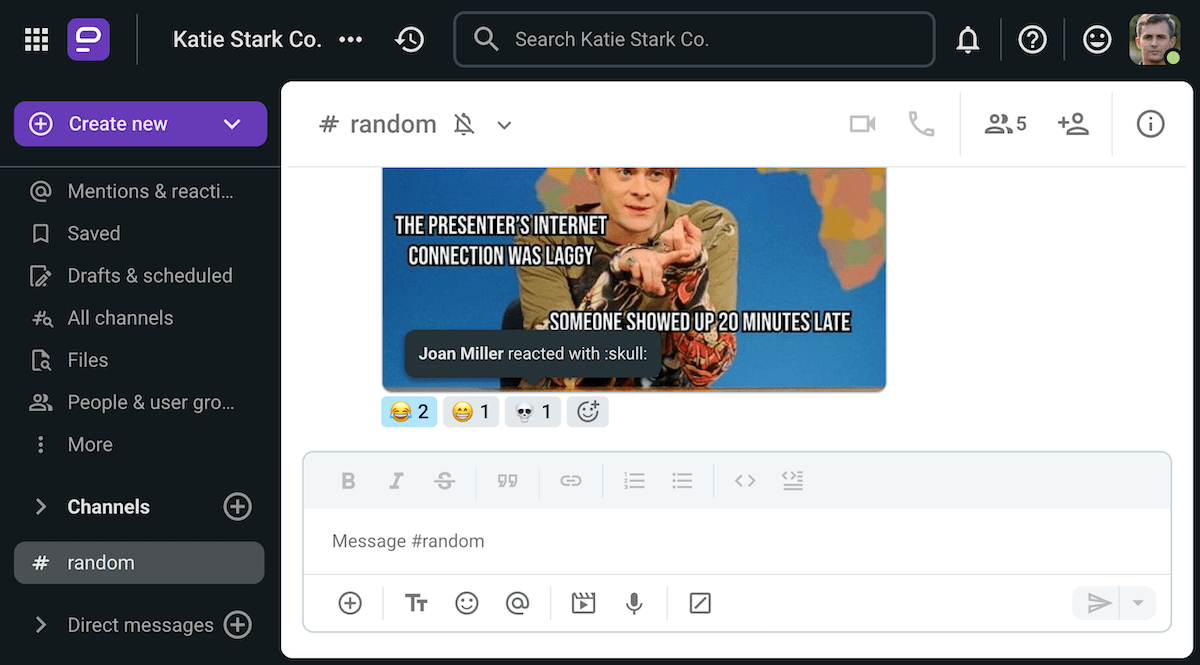
Use your favorite emojis to respond to messages on Pumble
Emoji usage in lateral and vertical communication at work
Since emojis are still seen as a casual form of expression, it should come as no surprise to learn that most people tend to primarily use them in communication with peers.
According to the US Emoji Trend Report:
- 24% of employees only use emojis in communication with their work friends,
- 24% use them with all other employees who are on the same level,
- 19% use emojis with everyone, regardless of level,
- 3% limit their use of emojis to coworkers who are not senior staff, and
- 1% only use them with junior colleagues.
According to these numbers, the reluctance to use emojis at work rises with the distance between the ranks of the interlocutors, at least in instances of upward communication.
On the other hand, downward communication seems less bogged down by these social conventions, as people in leadership positions tend to be less reserved with their emoji use.
Most managers know that a well-placed smiley face can reinforce their good intentions, especially when providing feedback to a member of their team.
After all, according to the US Emoji Trend Report, most people believe that emojis can make positive news or feedback more sincere, with:
- 73% of Millennials,
- 72% of Gen Z workers,
- 65% of Gen X employees, and
- 55% of Boomers agreeing with the claim.
Moreover, Adobe’s 2019 report also indicated that emojis can soften negative feedback, with 53% of respondents agreeing that emojis can make negative news or feedback easier to accept.
Emoji usage across communication channels
According to the most recent Pumble Workplace Communication Statistics, most employees primarily use email, online chat tools, and project management tools to communicate both with their coworkers and with external collaborators.
Naturally, using emojis in messaging apps like Pumble is a given, as they offer a multitude of ways to incorporate these symbols into our communication.
Over time, most internal communication apps will even take into account your emoji usage and provide quick access to your favorite emojis, as shown below.
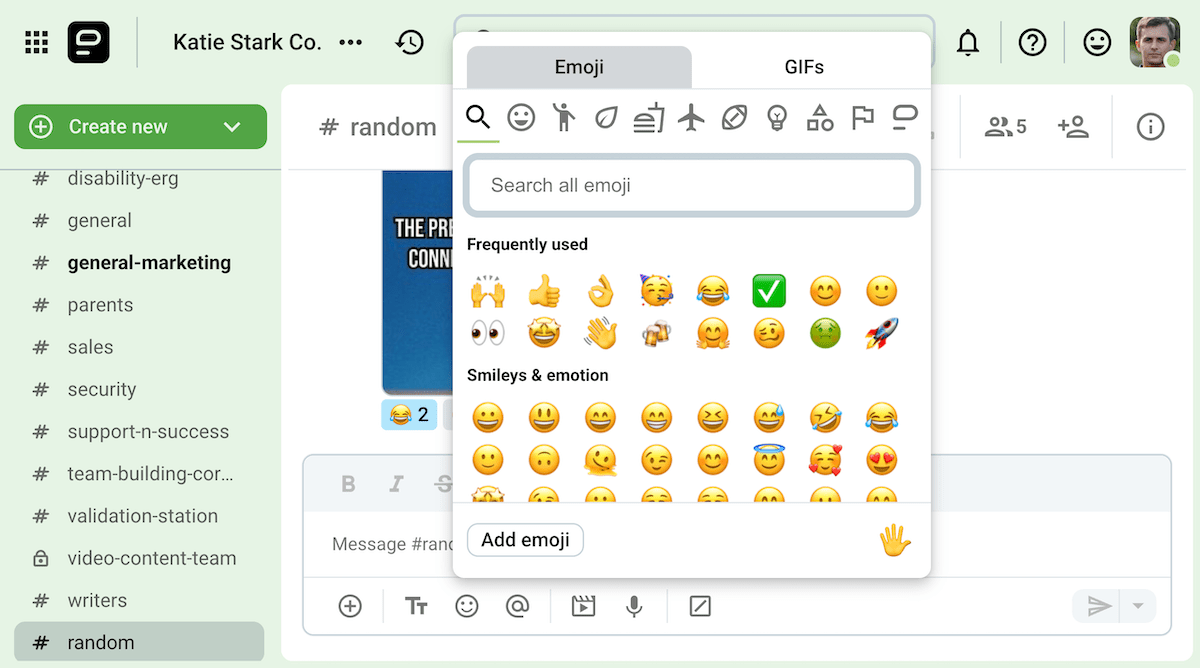
Teach Pumble your favorite emojis!
But, what about other channels of communication, like email? Is email too formal for emojis?
Well, according to the results of the Crossword-Solver survey we mentioned earlier, using emojis in emails can be a bit of a coin toss, as:
- 19% of survey participants perceive emojis in work emails as friendly,
- 13.8% say they see them as informal,
- 9.2% are not keen on them and perceive them as unprofessional, and
- 9.1% say emojis can make work emails appear more personal.
Then, there’s the question of whether this hypothetical emoji-riddled email is addressed to a coworker, a higher-up, or an external collaborator.
Generally, though, most people would advise against sending emojis to superiors or external collaborators, as the recipients of the message may not appreciate that level of familiarity.
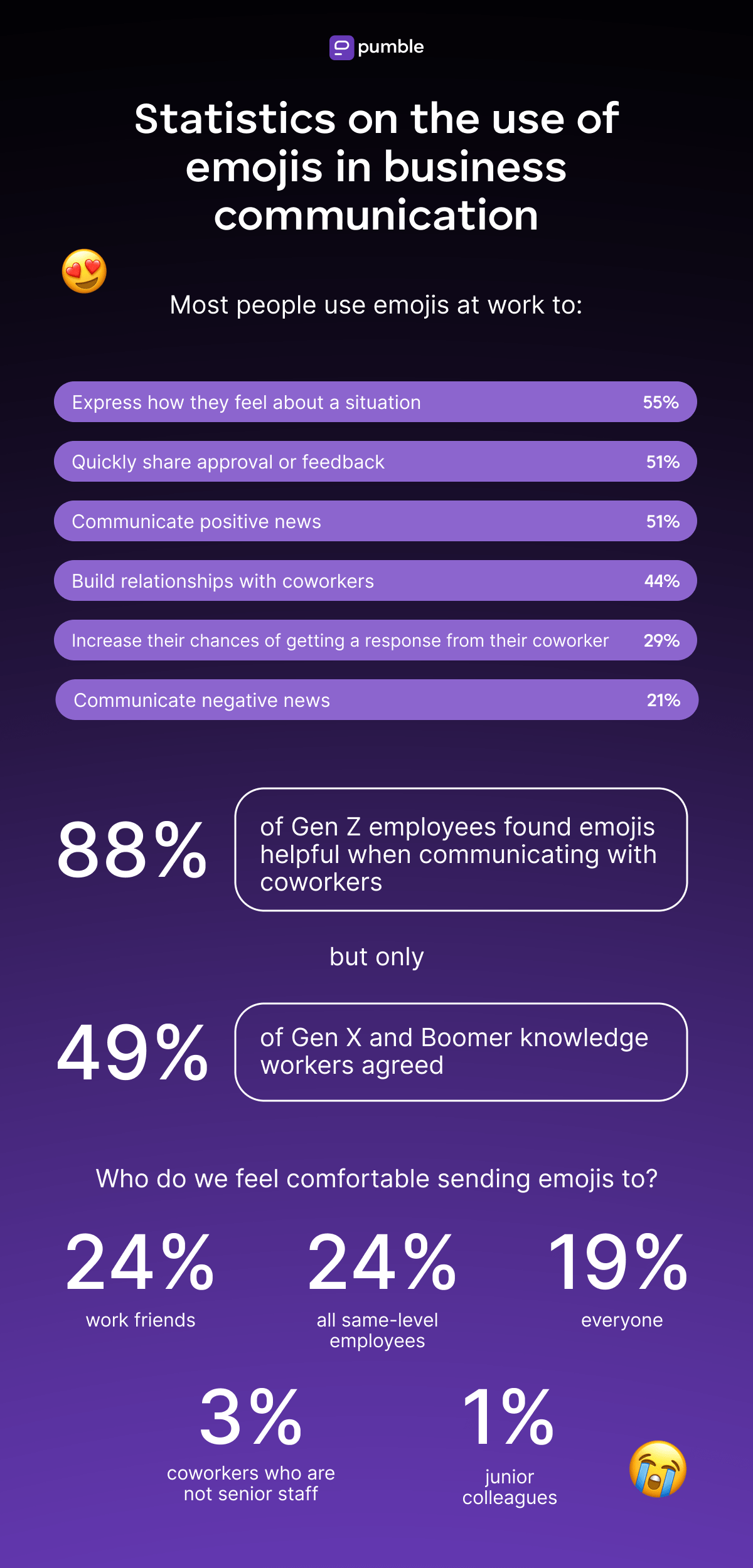
How to use emojis in business communication
Ultimately, emojis can be both beneficial and detrimental to communication in different ways.
On the one hand, they can make communication simpler, if the conversation participants understand the intended meaning of the emojis that are being sent.
On the other hand, miscommunication is also possible, especially if people don’t have the same interpretation of the emojis they’re sending and receiving.
Furthermore, different generations can have different opinions as to whether emojis are an appropriate aspect of a conversation in the first place.
Still, there are ways to incorporate emojis into your business communication without causing unnecessary confusion.
When in doubt, defer to the other participants of the conversation and use emojis only if they do.
Even then, limit yourself to the exact set of symbols they’re using — or at least stay in the same range of responses.
In other words, you don’t need to respond to the 🙂 Smiling Face emoji with the same one, but you could use a similar symbol (😊, 😄, 😁) to mirror your interlocutor’s intent.
Alternatively, if you don’t want to wait for other people to use emojis first, you could just use emojis with clear and unambiguous meanings to begin with.
Boost collaboration by using emojis in Pumble
If you were wondering about the future of emojis in the workplace, one thing is certain — they are here to stay.
With tools like the team communication app, Pumble, you can leverage this trend to foster more engaging and expressive communication in the workplace.
Pumble’s custom emoji feature gives you the freedom to create personalized emojis or utilize the existing ones to:
- React to others’ messages,
- Highlight crucial points and capture attention,
- Facilitate agreements and arrangements, or
- Indicate your availability status to colleagues.
All in all, embracing emojis as part of business communication can enhance collaboration, strengthen relationships, and contribute to a more connected workplace culture.
Ready to enhance your team communication with emojis?
How we reviewed this post: Our writers & editors monitor the posts and update them when new information becomes available, to keep them fresh and relevant.

